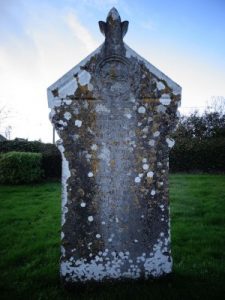 A recent research project took me to a headstone in Terryglass in north Tipperary (historicgraves.com). It was erected by a Daniel Hogan in memory of his father John, who died in 1856, and it included mothers’ maiden name, siblings, ages at death – wonderful stuff that took the family well back into the 18th century.
A recent research project took me to a headstone in Terryglass in north Tipperary (historicgraves.com). It was erected by a Daniel Hogan in memory of his father John, who died in 1856, and it included mothers’ maiden name, siblings, ages at death – wonderful stuff that took the family well back into the 18th century.
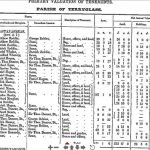
My focus was also Daniel Hogan, listed as occupying 40 acres in the townland of Cappanasmear in Terryglass in Griffith’s Valuation, published for this area in 1852. Could they be the same person?
Circumstantial evidence is all that survives. So first, I needed to check how many households in Terryglass were headed by a Daniel Hogan between 1827 and 1857. The baptismal registers (rootsireland.ie) show no fewer than 12 separate Hogan families headed by a Daniel. Not good news. But the Cappanasmear Hogans seem to have been the most prosperous, so there was still hope.
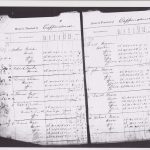
The Griffith’s manuscript notebooks for Terryglass from 1845 were next. Daniel was there, but the difference with the published record showed the effect of the Famine on the townland. In the seven years to 1852, three of his neighbours’ holdings had vanished.
Because the Valuation was a tax record, it had to be updated regularly.
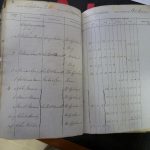
The first revision in the Valuation Office, dated 1857, showed the ongoing catastrophic impact of the Famine. Of 21 houses listed in Cappanasmear in 1845, by 1857 only 11 remain. And Daniel is gone, his house demolished, his land absorbed into neighbours’ holdings. This doesn’t look like someone who was erecting a carefully-carved gravestone commemorating a death that took place in 1856.
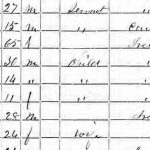
Where did the family go between 1852 and 1857? An 1855 state census shows four of them in upstate New York. And Daniel’s wife, Ann, records that she arrived in the US two years previously and has been a widow for a year. So my Daniel could not have been in Terryglass in 1856 and could not have put up that wonderful headstone.
Negative outcomes can be just as important as positive ones. But I still cling to the hope that something will disprove my disproof.
Reading about the steps in your process for identifying people was quite helpful. It also helps that you explained how to understand the information in the Valuation Books. So many stories could be told from those pages.
Thank you, John, for again validating the importance of digging to connect our dots!
Hi John,
I love your blog. I am only starting to use griffith’s and the tithe applotment books to go deeper on my Irish born ancestors so posts like this are helpful to me.
I am curious how you made the connection between your Hogans in Ireland and the 1855 Hogans in Chili (pronounced where both sylables rhyme with eye, rather than the TexMex bean stew, in case you were interested) New York. There are dozens of Daniel Hogans and hundreds of Ann Hogans. I am usually trying to go the other way – identifying my Irish ancestor who I have traced back to their recent entry in the US. It always stumps me.
I’m equally curious about how you made the connection to the Chili, New York, Hogans. Also, where did you learn how long Ann Hogan had been widowed and when she arrived in the U.S.? (The census confirms her arrival in Monroe County two years earlier and that she was widowed, but not when.)
The limited information in the 1855 NYS census suggests there’s an interesting (probably not terribly happy) story lurking in the numbers. Ann Hogan (65 yrs old), Michael (30 and blind), John (14), and Bridget (11) live in a log house, while Daniel Hogan (27) works as a servant in a larger framed house nearby. He arrived in Monroe County four years before the census. The family he works for and lives with is Irish. If Daniel is related, did he bring his family in when Ann Hogan was widowed? Did Daniel’s employer bring them all to Chili provide support?
Are the valuation books online yet?
Yes, the Griffith evaluation books are online and free at.. http://www.askaboutireland.ie/griffith-valuation/
(Some of the) Pre-publicaton notebooks are online at genealogy.nationarchives.ie. The post-publication revision books are online only for the six counties of Northern Ireland, at https://www.nidirect.gov.uk/proni.
Hi John, All,
I wonder if any of you have searched for a headstone in a graveyard or online with Historicgraves.com and have come across an old headstone but with all new inscriptions? Yesterday evening whilst looking through Historicgraves for a North Kilkenny graveyard for one family I came across another headstone belonging to a family I know of whose grandparents had been buried in the last ten years. I know one of this family well who has a photobook produced by a relative which includes family history and details and photos of this headstone. It would have contained details of relatives who lived in the late 1800s early 1900s. The problem is all these details have been ground away and the full face of the headstone is filled with details of the last two people buried in the plot. I came across similar in a country graveyard in South Laois where a headstone of a family related to my own had one had been fully ground back and details of the last person buried filling the whole face of the headstone. Is this a common practice? I presume it is allowed because people would own these plots but surely this is a form of vandalism? Historicgraves and the current interest in genealogy has come too late for these stones and their lost inscritions; the former still exists on a photo in a book; it would be better if it was still on the stone…
Impeccable logic, and beautifully presented as usual !
One little comment if i may – I came across a headstone inscription recording a death of a man in 1865, but found his death recorded in the General Register Office in 1864. Same name, same townland address, same month and same date, only the year differed.
I came to the conclusion that the headstone must have been erected some years after the death, and the incorrect year of death was inscribed on it.
Is it possible your Daniel Hogan’s headstone was erected some time later, possibly paid for by one of his descendants who had done well in the US ?